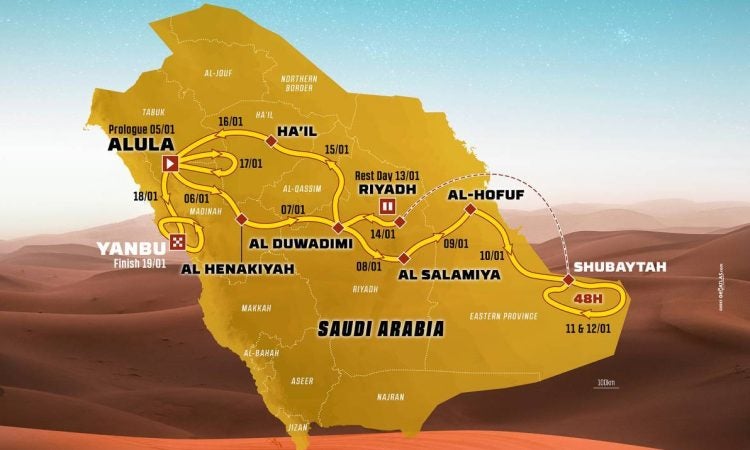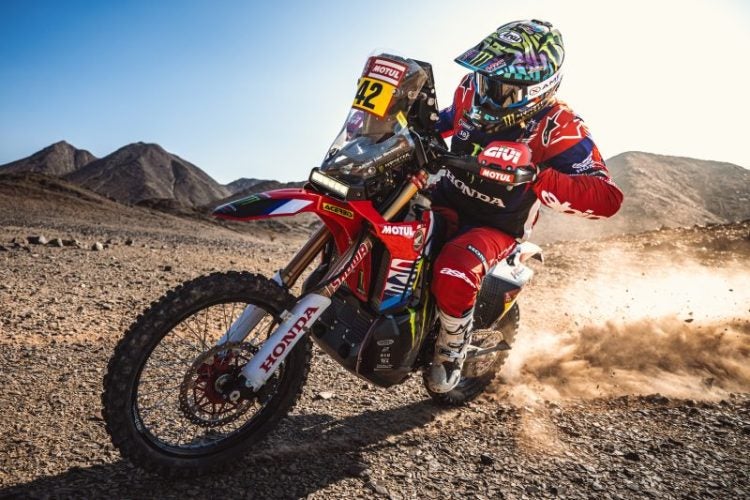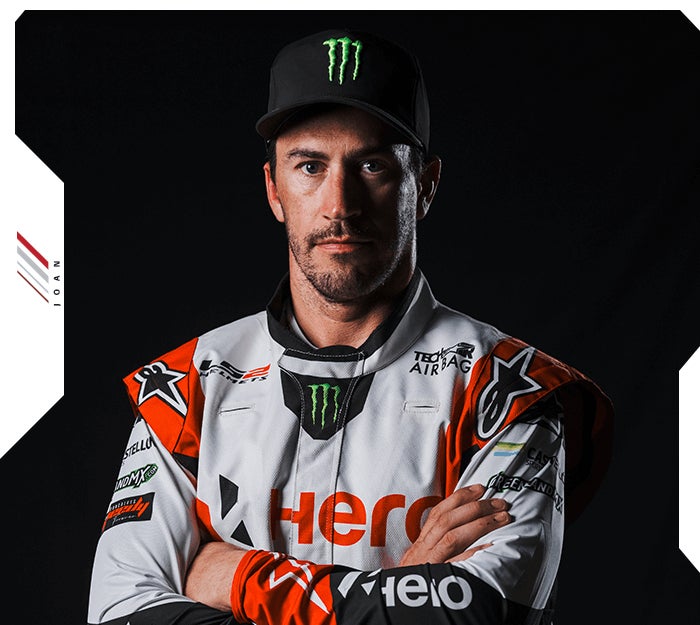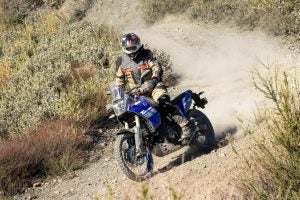It’s early January, and that means the Dakar Rally is about to start. Here’s a look at what we can expect as racing begins on January 5:
A Tough Route

Image: ASO
Although the race runs west-to-east entirely inside the country of Saudi Arabia, it still covers almost 8,000 kilometers this year. That includes 4,727 kilometers of timed special sections. The race runs January 5-19, running from AlUla to Yanbu, with a rest day in Riyadh between Stage 6 and Stage 7.
We get the usual talk of “toughest Dakar ever” from the organizers again. But while those guys are definitely prone to exaggeration (and are not beyond helping out their star racers, if they get too off-course), remember that it’s in the organizers’ interest to slow things down. Tougher terrain means slower speeds, and the big bosses are keen to slow the motorcycles down to avoid crashes resulting in injury and death.
The ASO says 60 percent of this year’s ride sections are all-new, so teams will be scrambling to figure out the mapping secrets on the fly, with much less capability to rely on work done in past races.
Rulebook revisions

Adrien Van Beveren will have an old-school paper roadbook, along with other RallyGP riders, but Rally2 mostly has electro-roadbooks this year. Photo: Honda Racing
No race series is complete without an annual turnover of rule changes for the fans to argue about. For the 2024 Dakar Rally, we see a revision to the second marathon stage, which will run in Saudi Arabia’s Empty Quarter. In this stage, organizers will set up six different campsites in the desert. After 4 PM on the first race day of the marathon stage, the riders must stop their racing, and instead of jockeying for position, they must instead head directly to the next campsite on the route. Do not pass Go, do not collect $200, etc., etc.
Why this change? Maybe it’s supposed to create artificial drama in the bivouac; good luck getting parts from your factory teammate, if that teammate is in another bivouac. Or maybe it will make some riders slow down, or speed up, in order to not get stuck in a bivouac they don’t want to be in. Whatever the reason, it’s pretty typical of the organizers at the ASO—a wacky, weird rulebook change that will almost certainly only last a year or three, and then disappear like so many other oddball regulations.
Another big rule change that is almost certainly here to stay: Many moto competitors will be switched to an electronic roadbook this year, but the rules are unevenly applied. This year, the Elite riders, the factory teams battling for top positions, are allowed to still run old-school, reliable paper maps. Almost everyone else is required to use a new electronic roadbook device (some riders in Rally2 class get an exemption, presumably because they are capable of challenging for a top-20 or top-10 slot).
There has already been some discontent voiced over the ASO’s required electro-navigation equipment, but the organizers say like-it-or-lump-it; their made-in-France gear is the standard. In other words, the same old capricious law-making from the ASO. Dakar may look a lot different from its days in Africa or South America, but some things will never change.
Lineup changes

Wait, wot? Bam Bam is not wearing a Honda sweater? Joan Barreda is now riding for Hero’s factory team. Photo: Hero
The rider lineup looks a lot different in 2024, compared to the race field we saw in 2023.
- Honda The biggest news this summer was Skyler Howes’ move to Honda. That leaves Honda with the two fastest American riders at Dakar, as Ricky Brabec is also on-board. It also means Honda is going into Dakar with the strongest factory team, since Howes was not replaced after leaving the Husqvarna team, and KTM’s crew is banged-up and also down a man. Honda, meanwhile, has the two Americans plus a whole host of other strong competitors. Jose Ignacio Cornejo returns for 2024, always a threat for a podium spot and a daily stage victory. Same goes for Pablo Quintanilla and Adrien Van Beveren. And just in case those guys can’t handle things, Honda also brought along youngster Tosha Schareina, who impressed in W2RC competition this year (including a win at the Argentina race). And once again, Ruben Faria is running the whole show. Add it all up, and Honda just might have the most formidable factory team to ever tackle Dakar.
- Husqvarna Aside from Howes’ departure, no changes here. Luciano Benavides is the only remaining racer on this team. He won the W2RC title in 2023, which is no guarantee of Dakar victory, but it shows he’s truly a top-level rider now. He reportedly had a wrist injury to sort out before Dakar. We haven’t heard much, so it can’t be serious.
- KTM For years, KTM was The Team To Beat at Dakar… and nobody was actually able to beat them. That’s changed over the past five years, but if everyone is healthy, KTM’s factory riders still have the best winning record at Dakar, by far. But in 2024, everyone isn’t healthy. Matthias Walkner broke his leg badly in a training crash, and will not race. Kevin Benavides also banged up his leg, and is heading to the Dakar with only five weeks of recovery time. However, Toby Price is still running for KTM, and he’s arguably the most alien-like rider in rally raid today.
- GasGas The third part of the Pierer AG-owned factory triple threat. Sam Sunderland returns, and seems healthy. Daniel Sanders also returns; he broke his leg badly about a half-year ago, and the word on the street is that he’s just getting back up to speed now. Sunderland proved he can win in the past, and Sanders is keen to show the same. Expect these guys to push hard, particularly as Sunderland appears to have no other setting besides “Win it or bin it.”
- Hero Speaking of “Win it or bin it,” everybody’s favorite crashaholic, Joan Barreda, has signed with Hero after many years on a Honda. While Hero might be seen as a second-tier team, combining Bam Bam’s speed with Mike Buhler, Ross Branch and Joaquim Rodrigues shows they’re very serious about this race. Will they win first place overall? Probably not, but they’ll probably do well in the dailies, and maybe get one or two guys in the top 10 if their bikes hold together. This is going to be perhaps the strongest up-and-coming team in the next half-decade.
- Kove This Chinese factory team made history by getting all three of their bikes across the finish line in 2023. Zhang Min returns for the team, with additions of Neels Theric and veteran Xavier Flick. But more interestingly, American rider Mason Klein is also on a Kove factory bike, although he is not part of the official factory team. It was a real struggle for Klein to get his bike into scrutineering on time, as Dubai’s customs held it up—but an all-night driving session by Kove’s team got it there! With that stress over, you can bet he’s keen to show he can pick up where he left off last year, before he had to leave the race due to injury.
- Fantic The Yamaha factory team is gone, replaced by Fantic, which is based very much on Yamaha’s old 450. Alas, Franco Picco is not riding for the team this year… but he is managing it!
- Sherco Rui Goncalves returns, and Lorenzo Santolino. Harith Noah is also on the team this year.






